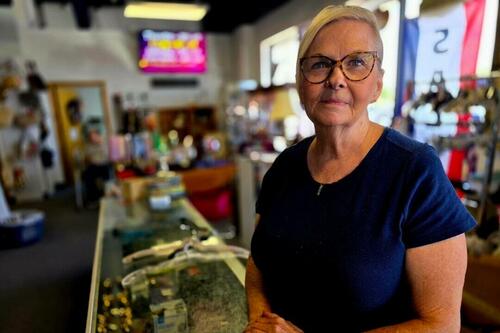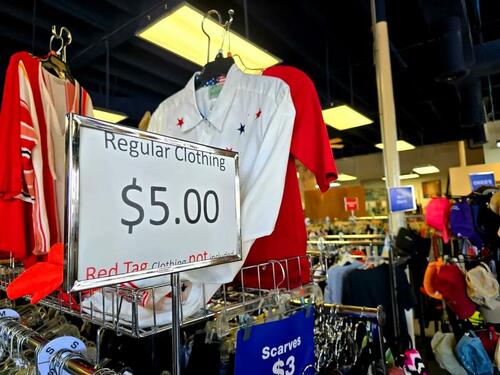
Frugality Rules As Americans Start Making The Most In A Hand-Me-Down Market
Authored by Allan Stein via The Epoch Times (emphasis ours),
PHOENIX—While many retailers have struggled, business has thrived since Estefania Gasca and her husband, Cristobal Zepeda, established Thrift It Forward consignment store in Phoenix nearly two years ago.
 Deborah Locker, an employee at Christian Family Care Thrift Store in Phoenix, Ariz., stands behind the sales counter on May 1, 2025. Allan Stein/The Epoch Times
Deborah Locker, an employee at Christian Family Care Thrift Store in Phoenix, Ariz., stands behind the sales counter on May 1, 2025. Allan Stein/The Epoch TimesSome days, the second-hand goods sell as quickly as they come in.
The couple has learned to appreciate the intrinsic value of old things, as second-hand resale and “do-it-yourself” repairs grow in popularity.
Gasca views it as a gradual paradigm shift—a new way of living based on old-school thinking.
“I feel like people are being more frugal. I feel that people are resorting more to buying second-hand rather than new,” said Gasca, standing behind the check-out counter on May 1.
“I feel like we haven’t experienced a [major] change just yet.”
COVID-19 revealed weaknesses in supply chains, resulting in empty store shelves and foreshadowing potentially worse situations due to global trade conflicts and import tariffs.
If it’s broken, second-hand tools can fix it as fine as new, Gasca said.
Used electronics, such as old gaming systems, computers, and digital devices, are among her best-selling products. They provide good quality at a significantly lower cost than large retail stores.
However, Gasca told The Epoch Times she is worried about the current unstable economy, which could lead to problems with pricing and availability, even for resellers like Thrift It Forward.
 Deborah Locker, an employee at Christian Family Care Thrift Store in Phoenix, Ariz., goes over prices on May 1, 2025. Allan Stein/The Epoch Times
Deborah Locker, an employee at Christian Family Care Thrift Store in Phoenix, Ariz., goes over prices on May 1, 2025. Allan Stein/The Epoch Times“We buy all of our stuff. We don’t get any donations,” Gasca said. “I’m afraid people will start selling more expensively. It will affect our prices. The [profit] margins won’t be as good.”
That means that thrift, budget, and consignment stores will have to start selling inventory at higher prices, undermining the purpose of buying second-hand items.
“We want to push reasonable prices because we know the economy is not as good,” Gasca said.
However, “we don’t want to raise our prices,” and there are indications that more challenging times may lie ahead.
If there’s a silver lining, Gasca said, Americans are becoming less wasteful and more practical with their personal belongings.
Hand-Me-Down World
Gasca said the country should be more self-sustainable. “We are a big throw-away society.”
“I feel a lot of people are coming in to buy [second-hand] as opposed to buying brand new, trying to keep their costs down,” she said.
“Automotive mechanics come to see us. We focus heavily on tools because there are a lot of fix-it-yourself people. Things go [fast].”
 A sign shows assorted clothing marked at $5 at the Christian Family Care Thrift Store in Phoenix, Ariz., on May 1, 2025. Allan Stein/The Epoch Times
A sign shows assorted clothing marked at $5 at the Christian Family Care Thrift Store in Phoenix, Ariz., on May 1, 2025. Allan Stein/The Epoch TimesAccording to research by Capital One Shopping, between 16 percent and 18 percent of Americans shop at thrift stores annually, visiting more than 25,000 resale, consignment, and nonprofit resale shops across the United States.
Of these consumers, 93 percent primarily shop online, with bargain hunters spending an average of $1,760 a year on second-hand items.
In 2023, the U.S. second-hand market generated $53 billion in revenue, projected to grow to $73 billion by 2028, according to Capital One’s research.
During this period, the clothing resale sector has grown 15 times faster than the overall retail apparel industry and should continue expanding at an annual rate of 17 percent through 2028.
The most commonly thrifted items include clothing (67 percent), books (60 percent), furniture (49 percent), shoes (36 percent), and toys (29 percent).
‘Planned Resilience’
At the Christian Family Care Thrift Store in Phoenix, volunteer cashier Deborah Locker has noticed an increasing interest in recycling old items, commonly known as “thrifting.”
She sees it as a logical progression in a throw-away society, and people are often surprised by the quality of second-hand items.
“We got a new Prada purse yesterday,” which usually retails for hundreds of dollars, and now is selling at a fraction of the cost, Locker told The Epoch Times.
 Estefania Gasca, co-owner of Thrift It Forward consignment store in Phoenix, Ariz., adjusts items on a shelf on May 1, 2025. Allan Stein/The Epoch Times
Estefania Gasca, co-owner of Thrift It Forward consignment store in Phoenix, Ariz., adjusts items on a shelf on May 1, 2025. Allan Stein/The Epoch TimesWith other items, they will say, “What a bargain! It would have cost me $60, but I got it for $20.”
“I’ve seen more information on thrifting on the internet lately,” Locker said. “They’re in my news feeds.”
As global trade encounters increasing disruptions, Locker envisions a domestic economy focused less on planned obsolescence and more on planned resilience.
Locker said she tries to be a good steward of the world’s resources, not a “throw-away” person.
Thrifting is one way of expressing that conviction.
It often involves do-it-yourself repairs, and Marlina Kessler, co-owner of Bernina Connection in Phoenix, believes that knowing how to sew and mend clothes is an essential skill for the 21st century.
The sewing shop offers classes specializing in Bernina sewing machines, regarded as the Mercedes-Benz of the industry, along with fabrics and quilting supplies.
At the top of the sewing machine sales line is the B735 computerized patchwork edition, which sells for around $8,000.
“It’s amazing. I tell people it’s like a CNC machine that sews instead of cuts [metal],” Kessler said.
Kessler is primarily a garment “sewist” rather than a traditional quilter.
When she purchased the shop, established in 2002, she leaned more toward fabric sales and garment repair.
With rising prices and a renewed interest in extending the lifespan of clothing, Kessler believes that “fast fashion” is declining.
Fast fashion refers to the rapid and inexpensive production of trendy clothing that saturates the market. This phenomenon goes hand in hand with a culture of disposability.
Kessler said that this is where sewing and mending skills truly shine.
“We do a lot of classes. I’ve got a 23-year-old son, and he is much more aware than I ever was at that age about our environment, things that are just disposable,” Kessler said.
“I think the newer generation is placing much more value in sustainable things, creating clothing, and getting good products.”
New Life From Old Clothes
Purchasing second-hand items gives new life to old fabrics and reduces the cost of alterations, Kessler said.
“These bundles here are made from vintage quilts,” she said, pointing to a set of fabrics.
“And people will use that for what they call visible mending. They‘ll make their patches. Sometimes, they’ll stitch and elaborate, making them look cute.”
Currently, students in the Bernina Connections sewing classes are learning how to “upcycle,” which involves creatively reusing fabrics.
At the same time, Kessler knows that many of her suppliers are worried about import tariffs and the potential increase in wholesale prices.
“Our machines are going up in price across the board. We’re going to try to absorb as much of it so that we don’t see that [passed on] to the consumer,” Kessler told The Epoch Times.
When it comes to clothing, Kessler is practical and thinks long-term.
Why spend $100 on a new pair of fashion slacks or denim jeans when you can fix the ones you have for much less?
Why choose a shirt that lasts only a couple of years when you can repair one and make it last a decade or more?
Kessler said there’s pride in mending and creating clothing and value in keeping things longer.
Buying new items means spending a lot of money in some cases, constantly. And in the garment industry, there are certain immutable realities.
One is, “You’re always going to need to take up or let out your slacks,” Kessler said.
“You’re always going to need to shorten tops. It used to be so easy to say, ‘Oh, I’ve got a hole in my jeans, I’ll just go and buy a new pair.’
“Now, that option is more difficult. So we do classes on how to patch them up.”
For thrift store customer Sara Stafford of Phoenix, it’s all about product longevity and finding treasures “wherever you are.”
She is not very concerned about import tariffs at the moment.
“I think it’s going to build back up soon, especially with the small businesses,” Stafford said.
“And if we give back to our small businesses, it will be booming again.”
Tyler Durden
Wed, 05/21/2025 – 21:45

 3 miesięcy temu
3 miesięcy temu











![„Raz sierpem, raz młotem, czerwoną hołotę”. Kolejny atak na olsztyńskie „szubienice”. Kto stoi za aktem wandalizmu? [ZDJĘCIA]](https://static.olsztyn.com.pl/static/articles_photos/44/44591/0ddf0751c9287e16d09122c78f8356f1.jpg)
